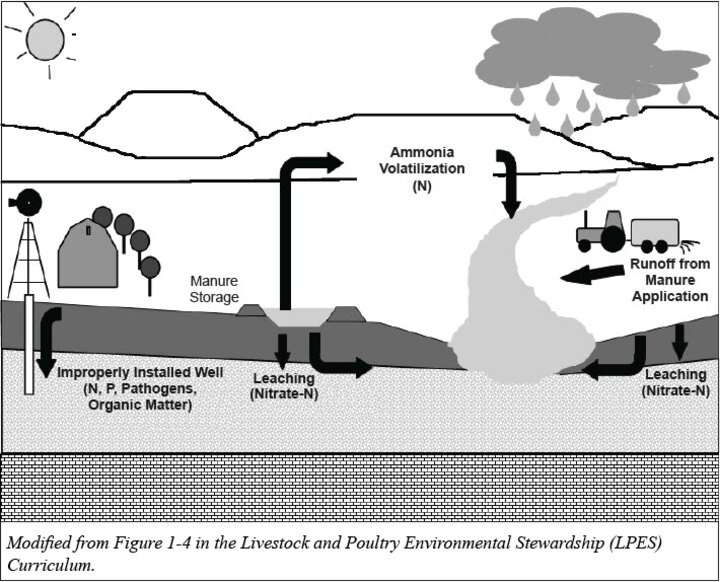
Water quality can be degraded by contaminants contained in manure, from water used at milking centers, from silage leachate, and from open lot runoff. These potential pollutants typically follow one or more possible pathways to water (see figure to the right).
Runoff: Runoff from open lots, land application sites, and manure and feed storage units is a common pathway for contaminant transport. All contaminants in manure can travel with surface water runoff and through soil erosion. Problems associated with phosphorus, pathogens, ammonia, and organic matter most commonly are associated with runoff and/or erosion.
Leaching: Dissolved contaminants such as nitrate will leach through the soil when the soil moisture exceeds its water-holding capacity. Most contaminants in manure and other by-products (organic matter, pathogens, and typically phosphorus) are filtered by the soil and generally will not leach to groundwater. Soil structure, chemical bonding with soil minerals, and negatively charged soil particles typically restrict the movement of most contaminants. However, soluble contaminants such as nitrate may move beyond a crop’s root zone and contaminate groundwater.
Well casings: Well casings can provide a direct pathway for contaminants to reach groundwater. Abandoned wells, wells with poor well-casing designs, or wells located in close proximity to open lots or manure storage can provide a pathway for manure contaminants to move to groundwater.
Ammonia volatilization and deposition: Ammonia volatilizes from manure storage, lagoons, open lots and land applications without incorporation. Once volatilized, most ammonia is re-deposited with rainfall or through dry deposition. It can be transported over long distances. Many areas of the world profit from this nutrient deposition. However, some areas of the world are experiencing deposition rates that threaten vitality and growth in local ecosystems. In the United States, coastal areas are often adversely affected by atmospheric ammonia deposition.
The five major contaminants associated with livestock and poultry by-products, their environmental risk, and common pathway to water are summarized in the table below.
Nitrate
Fish Kills
Methemoglobinemia
Pathogens
Human Health Risk
Phosphorus
Surface Water Runoff
| Potential Contaminant | Environmental Risk | Most Common Pathway to Water |
|---|---|---|
|
Leaching
|
||
|
Ammonium
|
Surface Water Runoff
|
|
|
Eutrophication (Algae Blooms in Lakes)
|
Erosion and Surface Water
|
|
|
Surface Water Runoff
|
||
|
Organic Solids
|
Reduced Oxygen Level in Water Body - Fish Kills
|
|
| Modified from Table 1-3 in the LPES Curriculum. | ||
Part I of Water Quality Issues | Part II - Pathogens and Organic Matter | Part III - Contaminant Pathways | Complete the Quiz